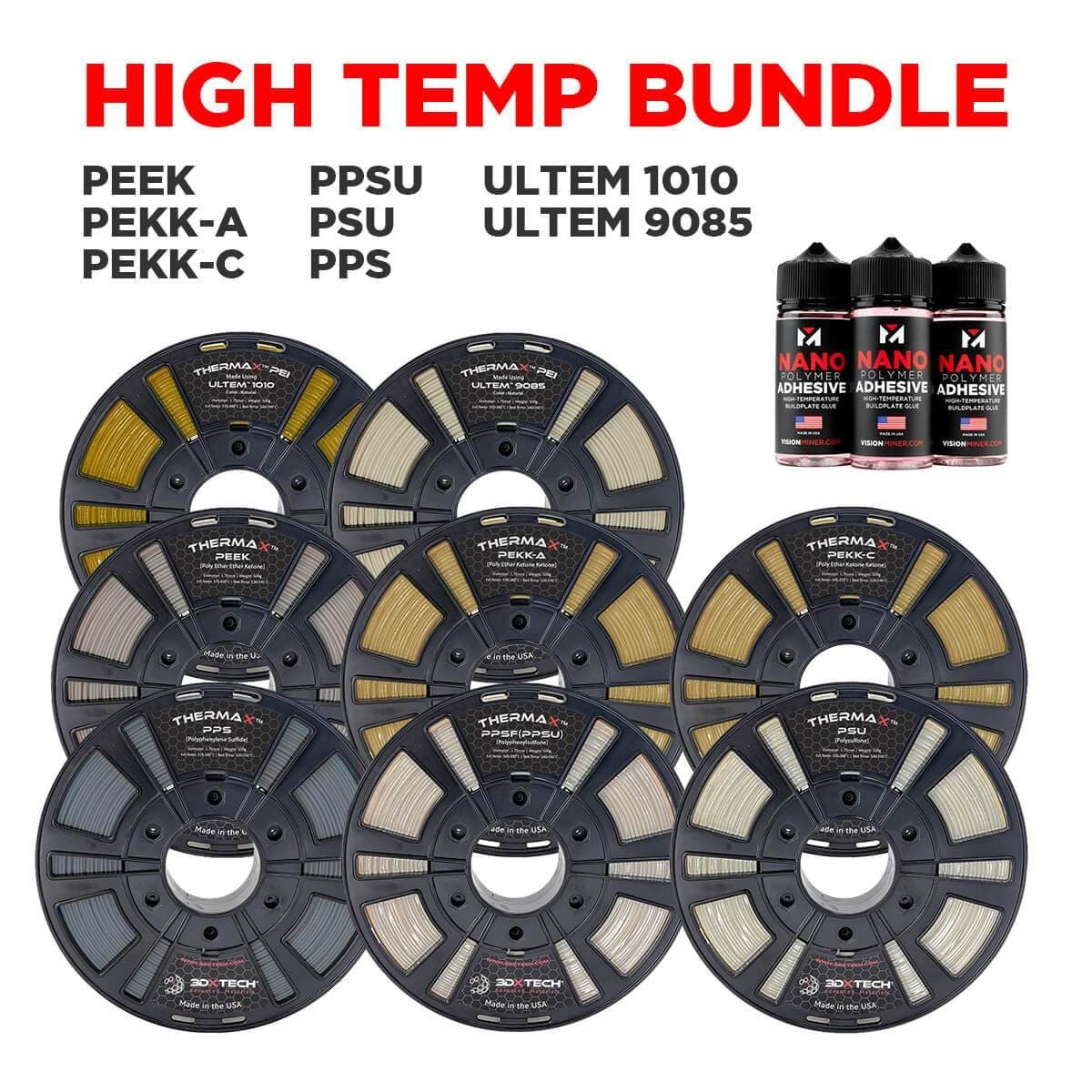From material selection to slicer tuning and safe printing environments—plus a pro-level alternative when you’re ready to scale.
What Is High-Temperature 3D Printing?
High-temperature 3D printing refers to the use of materials that require:
- Nozzle temperatures above 300°C
- Heated beds over 100°C
- Enclosed or actively heated build chambers
This process enables parts that are:
- Highly heat-resistant
- Mechanically strong
- Chemically resistant
- Biocompatible (in some cases)
Common materials include:
| Material | Extruder Temp | Bed Temp | Chamber Temp | Notes |
|---|---|---|---|---|
| PEEK | 360-450°C | 120-160°C | 70-140°C | Aerospace-grade, strong and biocompatible |
| PEI (Ultem) | 350-390°C | 120-160°C | 70-100°C | Good for electrical & structural parts |
| PPSU | 350-400°C | 110-150°C | 60-90°C | Excellent chemical resistance |
| PC/CF | 290-330°C | 110-120°C | 40-70°C | Strong, light, abrasive |
| PA-CF | 260-290°C | 90-110°C | Recommended | Moisture-sensitive, needs drying |

Step 1: Choose or Build a Capable Printer
If you’re printing these materials regularly, you’ll need a machine that can handle it. Key features:
Required Hardware Features:
- All-metal hotend (no PTFE near the melt zone!)
- High-temp thermistor (up to 500°C, e.g., PT100 or thermocouple)
- Nozzle: Hardened steel or ruby-tipped for carbon-fiber materials
- Heated bed (110°C+)
- Fully enclosed chamber (actively heated, if possible)
- High-temp resistant belts and bearings
Recommended Printers:
- Raise3D Pro3 HT
- Intamsys Funmat HT Enhanced
- Creatbot F430
- Prusa XL with Enclosure (for lower-end high-temp work)
DIY option: Upgrade an Ender 3 or Voron with:
- Slice Engineering Mosquito Magnum hotend
- Keenovo silicone heated bed
- Custom polycarbonate enclosure
- Duet 2 or Klipper firmware with thermocouple support
Step 2: Calibrate and Tune Your Slicer
Printing high-temp materials is unforgiving without proper slicer configuration. Here’s a baseline to start:
Recommended Cura/PrusaSlicer Settings:
(Use with care and test with your setup)
| Setting | Suggested Value for PEEK/Ultem |
|---|---|
| Layer Height | 0.2 mm |
| Nozzle Temp | 400°C |
| Bed Temp | 140°C |
| Chamber Temp | 90°C |
| Retraction Distance | 0.5-1.5 mm (direct drive) |
| Retraction Speed | 20-30 mm/s |
| Print Speed | 20-40 mm/s |
| Cooling Fan | OFF |
| Support Interface | 0.2 mm gap, low interface density |
| First Layer Height | 0.3 mm |
| Skirt/Brim | Yes – 5-10 lines |
Always perform a temperature tower and retraction test first.
Step 3: Prep and Maintain Your Materials
Why?
High-performance filaments like PEEK, PA, and Ultem absorb moisture quickly-this leads to bubbling, poor adhesion, and delamination.
How to Dry:
- PEEK / PEI / PC / Nylon CF: 4-6 hours at 80-120°C
- Tools: PrintDry Pro, SUNLU FilaDryer, or lab oven with temperature control
Store filaments in airtight containers with desiccants when not in use.
Step 4: Manage Heat & Safety
- Insulate your hotend with high-temp silicone socks
- Seal the chamber to maintain heat and avoid warping
- Install smoke detectors & fire extinguishers
- Use external air filtration (HEPA + activated carbon) for fumes
- Always supervise long prints, or use remote camera monitoring
Tip: Add thermal cutoff fuses in your printer for fail-safe protection.
Step 5: Test, Fail, Adjust, Repeat
- Start with smaller prints
- Use calibration cubes to validate layer bonding
- Check warping, layer adhesion, stringing
- Use heat gun + IR thermometer to measure chamber consistency
Document each change to refine your process. High-temp printing is a marathon, not a sprint.
Don’t Want to Tackle All This? Try Industrial-Grade Services
Setting up your own high-temp system is rewarding-but time-consuming, expensive, and often frustrating.
That’s where FacFox comes in.
Why Choose FacFox?
- Access to industrial-grade machines (Stratasys, Intamsys, 3D Systems)
- Full support for PEEK, PEI, PC, PA-CF, and more
- Engineering assistance to optimize part orientation, supports, and strength
- Rapid turnaround with competitive pricing
- ISO-certified quality and wide material library
Whether you’re developing prototypes or need end-use mechanical parts, we’ll deliver results-no thermal runaway errors or filament jams.
Ready to go beyond desktop limits? Get a quote from FacFox now!
Conclusion
High-temp 3D printing is a gateway to elite-level parts – but it demands serious gear, care, and patience. If you’re committed, this guide should get you started the right way.
If not, you can still benefit from these materials without the overhead-by working with professionals like FacFox, who are already set up to deliver.
Have questions about your project or setup? Leave a comment or reach out-we’re here to help!